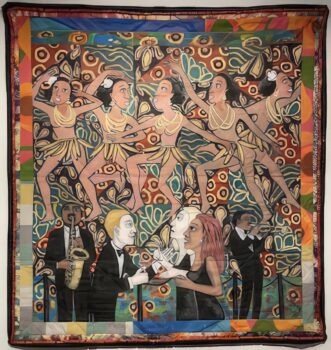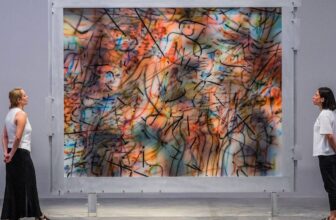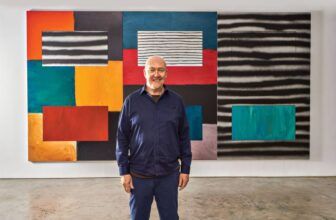Faith Ringgold: Storyteller, Activist and Visionary
Faith Ringgold is a name synonymous with resilience, innovation, and storytelling. An artist whose work transcends canvas and color, she is a cultural icon whose art has changed the landscape of American history. With a career that spans over six decades, Ringgold’s bold quilts, vibrant paintings, and deeply narrative pieces give voice to the African American experience in ways few others have done. Her art is more than visual, it is a living archive of stories, identities, and struggles woven with brilliance.
This post delves into the life and work of Faith Ringgold, exploring her art’s cost, creation process, notable pieces, style, materials, and locations. Whether you’re an art lover, collector, or student of history, Ringgold’s legacy offers a profound lesson on how art can be a tool of change, connection, and identity.
Who is Faith Ringgold?
Born in Harlem, New York, in 1930, Faith Ringgold grew up during the Harlem Renaissance, a period of great cultural, artistic, and intellectual awakening in the African American community. She was raised by a strong, creative mother who was a fashion designer and encouraged her to express herself through artistic mediums from a young age.
Ringgold received her B.S. and M.A. degrees in visual art from the City College of New York. While she began her career as a painter, her artistic practice evolved to include story quilts, sculptures, performance art, and children’s books. Ringgold’s work addresses themes such as civil rights, feminism, racism, African American history, and family, all through the lens of her lived experience.
Her work doesn’t merely reflect the world around her; it challenges it. Ringgold has long been a fierce advocate for racial and gender equity in the art world, and she fought tirelessly to have Black artists represented in museums and galleries.
Faith Ringgold is best known for her story quilts, a unique fusion of painting, quilting, and narrative storytelling. While traditional quilts are made primarily for warmth and decoration, Ringgold’s quilts are richly layered with painted images and handwritten texts. They tell stories about her life, African American history, and broader social issues. These quilts are both deeply personal and widely relatable, allowing her to connect with viewers on multiple levels.
She is also recognized for:
Feminist activism in the art world
Children’s literature, especially her award-winning book Tar Beach (1991)
Political paintings such as the American People series (1960s), which tackled race relations and civil rights
Soft sculptures and masks inspired by African traditions
Performance art pieces and public murals
Ringgold challenged the boundaries of “fine art” by using materials and methods traditionally associated with women’s domestic work and elevating them to high art.
How Does Faith Ringgold Make Her Artwork?
Ringgold’s art-making process is layered and multidisciplinary. Her story quilts, for example, involve several complex steps:
1. Concept and Story Writing
She begins with a story or message she wants to tell, often autobiographical or inspired by the Black experience in America. She writes a narrative in her own handwriting or prints it directly onto the quilt. The story is essential, guiding the visual elements of the piece.
2. Painting the Canvas
Instead of traditional fabric quilting, Ringgold paints directly onto canvas. The central image of the quilt is created with acrylic paint, often showing scenes that illustrate the story being told.
3. Sewing and Bordering
Once the painting is finished, the canvas is sewn together with fabric borders and batting to give the piece the texture and softness of a quilt. This stage is typically done with the help of expert seamstresses, often her mother, Willi Posey, collaborated with her in the early stages of her career.
4. Final Assembly
The completed quilt is a fully integrated artwork, painting, writing, and textile. It is a self-contained story, readable and viewable in a single, coherent piece.
Her works are handcrafted but intellectually and emotionally rigorous. Every part of the process reflects her commitment to history, community, and craft.
What Art Style is Faith Ringgold Associated With?
Faith Ringgold’s art style defies easy categorization, but she is most closely associated with:
Storytelling Art
Narrative Art
African American Folk Art
Feminist Art
Political Art
Her American People series (1963–1967), for instance, combined Abstract Expressionism with social realism to depict race riots, protests, and inequality in the 1960s. Later, her quilts blended traditional African American quilting practices, folk narrative, and modernist painting. She is influenced by Romare Bearden, Jacob Lawrence, and African textiles.
Ringgold’s work is also deeply performative and conceptual. In the 1970s and 1980s, she began experimenting with soft sculpture and performance art, often wearing masks and narrating stories, connecting with African storytelling traditions and bringing her characters to life.
What Is Faith Ringgold’s Famous Artwork?
Some of Faith Ringgold’s most celebrated and well-known artworks include:
1. Tar Beach (1988)
This is perhaps her most famous story quilt and the basis for her beloved children’s book. Tar Beach tells the story of Cassie Louise Lightfoot, a young Black girl who dreams of flying over 1930s Harlem. It is a poignant, imaginative tale of freedom, aspiration, and empowerment.
“I can fly,” Cassie says. “That means I am free.”
The quilt combines painted scenes of rooftops with a lyrical narrative stitched around the borders.
2. The American People Series (1963–1967)
A powerful series of political paintings that comment on racism and segregation during the Civil Rights era. One of the most notable works from this series is Die (1967), a haunting depiction of racial violence, reminiscent of Picasso’s Guernica.
3. Who’s Afraid of Aunt Jemima? (1983)
This story quilt reclaims the stereotype of Aunt Jemima and transforms her into a successful businesswoman and matriarch. The quilt combines biography, fiction, and social critique, challenging viewers to rethink historical caricatures.
4. The French Collection (1991–1997)
This twelve-quilt series follows a fictional African American artist, Willia Marie Simone, who travels to Paris to become a painter in the 1920s. The work reimagines art history through a Black feminist lens, including reinterpretations of works by Matisse, Van Gogh, and Picasso.
How Much Does Faith Ringgold Art Cost?
The cost of Faith Ringgold’s art varies widely depending on the piece’s size, medium, provenance, and historical significance. Her major works, especially story quilts, have become highly valuable collector’s items.
Auction Records: In 2023, Ringgold’s story quilt The Flag is Bleeding #2 (1991) sold at auction for $1.5 million, setting a record for her work.
Smaller works or prints might sell for $10,000 to $100,000 depending on their importance and rarity.
Limited-edition lithographs or signed prints can range from $2,000 to $10,000.
Children’s book illustrations or smaller fabric pieces may cost less but are still considered collectible.
Her work’s value continues to rise as institutions and collectors recognize her significance in the canon of American and African American art.
How Many Artworks Does Faith Ringgold Have?
It is difficult to pinpoint the exact number of works Faith Ringgold has created, but estimates suggest:
Over 100 story quilts
Dozens of paintings from her early career
Over 30 sculptures and soft sculptures
Hundreds of drawings and sketches
13 children’s books (some illustrated by herself)
Multiple public commissions and murals
Ringgold’s prolific output is spread across various media, each extending her themes of justice, identity, and storytelling. Her catalog continues to grow as her work is newly discovered or cataloged by institutions.
What Materials Does Faith Ringgold Use?
Ringgold is known for her inventive use of mixed media, often blending traditional materials with unconventional forms. Common materials include:
Acrylic paint – For vibrant color and fast-drying surfaces.
Canvas – Painted canvas is often the center of her quilts.
Cotton fabric – Used to border and back her quilts.
Batting and thread – Traditional quilting materials to create dimension and warmth.
Paper and ink – For sketches, texts, and illustrations.
Yarn, beads, sequins – Occasionally used in sculpture and textile pieces.
Wood and soft fabric – Used in her three-dimensional soft sculptures and masks.
Her practice is deeply rooted in craft traditions, particularly those associated with Black women’s domestic labor, sewing, quilting, and embroidery, redefined as vehicles for high art.
Where is Faith Ringgold’s Artwork Located?
Faith Ringgold’s work is held in major public and private collections around the world. Here are some key places where her art can be found:
Major Museums:
The Museum of Modern Art (MoMA), New York – Home to Die (1967), part of the American People series.
The Metropolitan Museum of Art, New York
The Solomon R. Guggenheim Museum, New York
The Whitney Museum of American Art, New York
The Smithsonian American Art Museum, Washington, D.C.
The Brooklyn Museum
The Studio Museum in Harlem
Tate Modern, London
Universities and Cultural Institutions:
Harvard Art Museums
Spelman College Museum of Fine Art
University of California Collections
Public Installations and Murals:
Los Angeles International Airport (LAX) – Features her public mosaic mural.
New York City Public Schools and Libraries – Ringgold has created multiple murals and mosaics in community spaces.
Her work also travels globally through retrospective exhibitions and touring shows. The 2022–2023 major retrospective Faith Ringgold: American People showcased her work across multiple cities, further cementing her as a foundational figure in American art.
Faith Ringgold’s Enduring Impact
Faith Ringgold is more than an artist, she is a storyteller, activist, educator, and pioneer. Through her quilts, paintings, and books, she has built a bridge between generations, between the personal and the political, and between art and life.
Her work speaks with honesty and beauty about what it means to be Black, female, American, and human. In a world often divided by differences, Ringgold’s art invites us to find unity in story, color, and memory.
As the value of her art continues to rise, both culturally and financially, it is clear that Faith Ringgold’s voice is not just part of the historical record; it is essential to our collective future.




